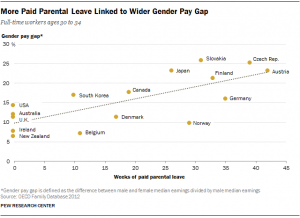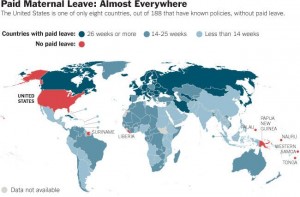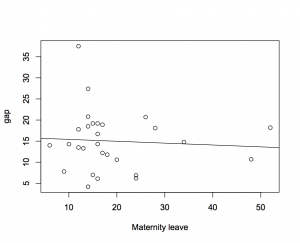More on gender pay gaps
Two things from Twitter today
1. A graph relating the gender pay gap and paid parental leave, from Pew Research
The positive relationship could be because gender discrimination (even if illegal) is more tempting when women are more likely to have prolonged parental leave. You could think of plenty of other possible explanations, too.
However, a fairly large fraction of the StatsChat audience should be looking at the bottom left corner of that graph and saying “Wait, what?”
2. Because, as shown in this map from the New York Times, New Zealand and Australia (and the UK and Ireland) actually have paid parental leave.
In a Twitter conversation it transpired that the OECD figures were only for parental leave that could be taken by either parent, not for maternity leave. But (a) that’s just bizarre if you want to explain gender pay gaps, and (b) it’s still wrong, as NZ parental leave can be transferred to the father, at least in part, and the same is true in Australia
Update: For comparison, if you plot gender pay gap from here against maternity leave from here you get this, with no sign of a relationship. So, at very least the relationship is quite sensitive to how you define parental leave. We would need a story about how leave entitlements for the father depress women’s income more than leave entitlements for the mother.
and as is so often the case, the Pew Research graph was “OECD highlights”, not all the OECD members for which the OECD has data.
Thomas Lumley (@tslumley) is Professor of Biostatistics at the University of Auckland. His research interests include semiparametric models, survey sampling, statistical computing, foundations of statistics, and whatever methodological problems his medical collaborators come up with. He also blogs at Biased and Inefficient See all posts by Thomas Lumley »



Isn’t it borderline deceptive to pick only the points that support the story that you want to tell?
I struggle with this all of the time when we do multiple analyses because people want to check for sensitivity. It feels like a bit cheating to pick the final model after knowing the results unless you are really up front about the exploratory nature of the work, especially if differences are large.
Shouldn’t they at least point out this sensitivity as part of the report? Or is this too confusing for a general audience?
11 years ago
Yes, and I’m a bit surprised, since I thought Pew Research were reliable.
11 years ago